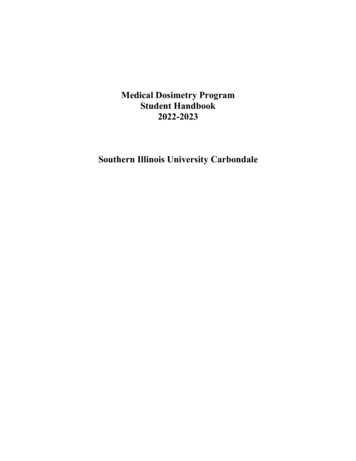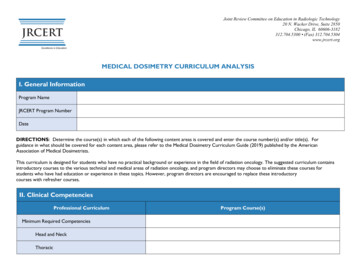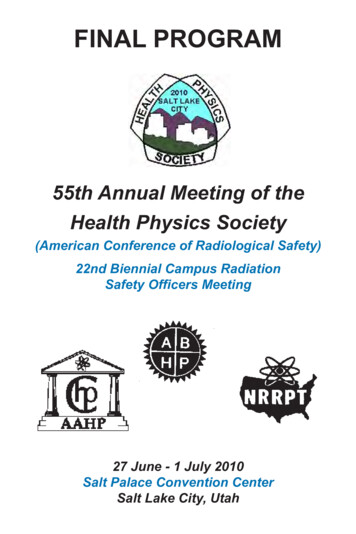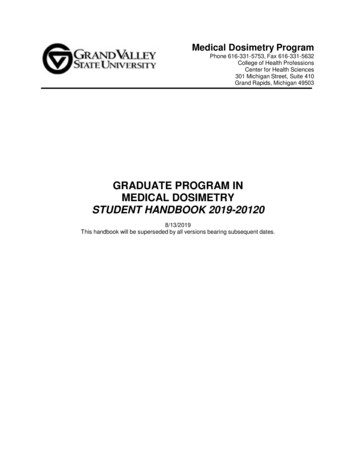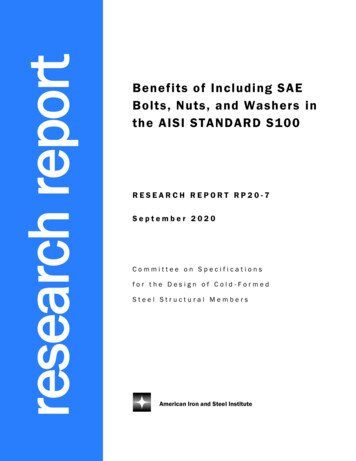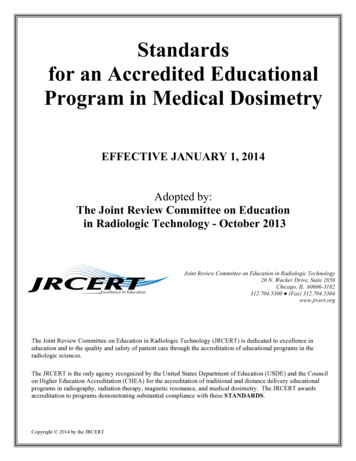
Transcription
Standardsfor an Accredited EducationalProgram in Medical DosimetryEFFECTIVE JANUARY 1, 2014Adopted by:The Joint Review Committee on Educationin Radiologic Technology - October 2013Joint Review Committee on Education in Radiologic Technology20 N. Wacker Drive, Suite 2850Chicago, IL 60606-3182312.704.5300 (Fax) 312.704.5304www.jrcert.orgThe Joint Review Committee on Education in Radiologic Technology (JRCERT) is dedicated to excellence ineducation and to the quality and safety of patient care through the accreditation of educational programs in theradiologic sciences.The JRCERT is the only agency recognized by the United States Department of Education (USDE) and the Councilon Higher Education Accreditation (CHEA) for the accreditation of traditional and distance delivery educationalprograms in radiography, radiation therapy, magnetic resonance, and medical dosimetry. The JRCERT awardsaccreditation to programs demonstrating substantial compliance with these STANDARDS.Copyright 2014 by the JRCERT
Introductory StatementThe Joint Review Committee on Education in Radiologic Technology (JRCERT) Standards for an AccreditedEducational Program in Medical Dosimetry are designed to promote academic excellence, patient safety, andquality healthcare. The STANDARDS require a program to articulate its purposes; to demonstrate that it hasadequate human, physical, and financial resources effectively organized for the accomplishment of its purposes; todocument its effectiveness in accomplishing these purposes; and to provide assurance that it can continue to meetaccreditation standards.The JRCERT accreditation process offers a means of providing assurance to the public that a program meets specificquality standards. The process helps to maintain program quality and stimulates program improvement throughprogram assessment.There are six (6) standards. Each standard is titled and includes a narrative statement supported by specificobjectives. Each objective, in turn, includes the following clarifying elements: Explanation - provides clarification on the intent and key details of the objective. Required Program Response - requires the program to provide a brief narrative and/or documentation thatdemonstrates compliance with the objective. Possible Site Visitor Evaluation Methods - identifies additional materials that may be examined andpersonnel who may be interviewed by the site visitors at the time of the on-site evaluation to help determine ifthe program has met the particular objective. Review of additional materials and/or interviews with listedpersonnel is at the discretion of the site visit team.Following each standard, the program must provide a Summary that includes the following: Major strengths related to the standard Major concerns related to the standard The program’s plan for addressing each concern identified Describe any progress already achieved in addressing each concern Describe any constraints in implementing improvementsThe submitted narrative response and/or documentation, together with the results of the on-site evaluationconducted by the site visit team, will be used by the JRCERT Board of Directors in determining the program’scompliance with the STANDARDS.2 Medical Dosimetry
Standards for an Accredited Educational Program in Medical DosimetryTable of ContentsStandard One: Integrity .4The program demonstrates integrity in the following: representations to communities ofinterest and the public, pursuit of fair and equitable academic practices, andtreatment of, and respect for, students, faculty, and staff.Standard Two: Resources .22The program has sufficient resources to support the quality and effectiveness of theeducational process.Standard Three: Curriculum and Academic Practices .34The program’s curriculum and academic practices prepare students for professionalpractice.Standard Four: Health and Safety .46The program’s policies and procedures promote the health, safety, and optimal use ofradiation for students, patients, and the general public.Standard Five: Assessment .55The program develops and implements a system of planning and evaluation of studentlearning and program effectiveness outcomes in support of its mission.Standard Six: Institutional/Programmatic Data.62The program complies with JRCERT policies, procedures, and STANDARDS to achieve andmaintain specialized accreditation.Awarding, Maintaining, and Administering Accreditation .703 Medical Dosimetry
Standard OneIntegrityStandard One:The program demonstrates integrity in the following: Representations to communities of interest and the public, Pursuit of fair and equitable academic practices, and Treatment of, and respect for, students, faculty, and staff.Objectives:In support of Standard One, the program:1.1Adheres to high ethical standards in relation to students, faculty, and staff.1.2Provides equitable learning opportunities for all students.1.3Provides timely, appropriate, and educationally valid clinical experiences for each admitted student.1.4Limits required clinical assignments for students to not more than 10 hours per day and the totaldidactic and clinical involvement to not more than 40 hours per week.1.5Assures the security and confidentiality of student records, instructional materials, and otherappropriate program materials.1.6Has a grievance procedure that is readily accessible, fair, and equitably applied.1.7Assures that students are made aware of the JRCERT Standards for an Accredited EducationalProgram in Medical Dosimetry and the avenue to pursue allegations of non-compliance with theSTANDARDS.1.8Has publications that accurately reflect the program’s policies, procedures, and offerings.1.9Makes available to students, faculty, and the general public accurate information about admissionpolicies, tuition and fees, refund policies, academic calendars, clinical obligations, grading system,graduation requirements, and the criteria for transfer credit.1.10Makes the program’s mission statement, goals, and student learning outcomes readily available tostudents, faculty, administrators, and the general public.1.11Documents that the program engages the communities of interest for the purpose of continuousprogram improvement.1.12Has student recruitment and admission practices that are non-discriminatory with respect to anylegally protected status such as race, color, religion, gender, age, disability, national origin, and anyother protected class.1.13Has student recruitment and admission practices that are consistent with published policies of thesponsoring institution and the program.4 Medical Dosimetry
1.14Has program faculty recruitment and employment practices that are non-discriminatory with respectto any legally protected status such as race, color, religion, gender, age, disability, national origin,and any other protected class.1.15Has procedures for maintaining the integrity of distance education courses.5 Medical Dosimetry
1.1Adheres to high ethical standards in relation to students, faculty, and staff.Explanation:High ethical standards help assure that the rights of students, faculty, and staff are protected. Policies andprocedures must be fair, equitably applied, and promote professionalism.Required Program Response: Describe the procedure for making related policies and procedures known. Provide copies of policies and procedures that assure equitable treatment of students, faculty, andstaff.Possible Site Visitor Evaluation Methods: Review of student handbook Review of employee/faculty handbook Review of course catalog Review of student records Interviews with faculty Interviews with students Interviews with staff6 Medical Dosimetry
1.2Provides equitable learning opportunities for all students.Explanation:The provision of equitable learning activities promotes a fair and impartial education and reducesinstitutional and/or program liability. The program must provide equitable learning opportunities for allstudents regarding learning activities and clinical assignments. If evening and/or weekend rotations areutilized, this opportunity must be equitably provided for all students.Required Program Response:Describe how the program assures equitable learning opportunities for all students.Possible Site Visitor Evaluation Methods: Review of published program materials Review of master plan of education Review of course objectives Review of student clinical assignment schedules Interviews with faculty Interviews with clinical preceptors Interviews with clinical staff Interviews with students7 Medical Dosimetry
1.3Provides timely, appropriate, and educationally valid clinical experiences for each admittedstudent.Explanation:Programs must have a process in place to provide timely, appropriate, and educationally valid clinical experiences toall students admitted to the program. Students must have sufficient access to an adequate variety and volume ofplanning processes to become competent in clinical practice. Clinical settings must provide a sufficient variety andvolume to allow all students to achieve required program competencies. Clinical settings may include hospitals,clinics, specialty centers, and other facilities. With the exception of observation site assignments, students must beprovided the opportunity to complete required program competencies during clinical assignments. Clinical placementmust be non-discriminatory in nature and solely determined by the program.Assignments to a treatment planning laboratory (ies), while educationally valid, shall not replace assignments toclinical settings.A meaningful clinical education plan assures that activities are educationally valid and prevents the use of students asreplacements for employees. The medical dosimetry student to clinical staff ratio must always be no more than 2:1.Activities that have minimal educational value must be limited in scope.Traditional programs that require students to participate in clinical education during evenings and/or weekends mustassure that: students’ clinical clock hours spent in evening and/or weekend assignments must not exceed 25% of thetotal clinical clock hours. program total capacity is not increased through the use of evening and/or weekend assignments.The JRCERT defines the operational hours of traditional programs as Monday - Friday, 5:00 a.m. - 7:00 p.m.Programs may permit students to make up clinical time during term or scheduled breaks; however, they may not beassigned to clinical settings on holidays that are observed by the sponsoring institution. Program faculty need not bephysically present; however, students must be able to contact program faculty during makeup assignments. Also, theprogram must assure that its liability insurance covers students during these makeup assignments.Required Program Response: Describe the process for student clinical placement. Provide current student assignment schedules in relation to student enrollment. Describe how the program assures a 2:1 student to clinical staff ratio at all clinical settings. Describe how the program assures that all students have access to a variety and volume of procedures toachieve program competencies. Submit evening and/or weekend rotation(s) calculations, if applicable.Possible Site Visitor Evaluation Methods: Review of published program materials Review of listing of enrolled students in relation to clinical assignments,including evening and weekend, if applicable Review process of clinical placement Review of student clinical records Interviews with faculty Interviews with clinical preceptors Interviews with students8 Medical Dosimetry
1.4Limits required clinical assignments for students to not more than 10 hours per day and thetotal didactic and clinical involvement to not more than 40 hours per week.Explanation:This limitation helps assure that students are treated ethically. For the safety of students and patients, notmore than ten (10) clinical hours shall be scheduled in any one day. Scheduled didactic and clinical hourscombined cannot exceed forty (40) hours per week. Hours exceeding these limitations must be voluntaryon the student’s part.Required Program Response: Describe the process for assuring that time limitations are not exceeded. Provide documentation that required student clinical assignments do not exceed ten (10) hours in anyone day and the total didactic and clinical involvement does not exceed forty (40) hours per week.Possible Site Visitor Evaluation Methods: Review of master plan of education Review of published program materials Review of student schedules Interviews with faculty Interviews with clinical preceptor(s) Interviews with clinical staff Interviews with students9 Medical Dosimetry
1.5Assures the security and confidentiality of student records, instructional materials, and otherappropriate program materials.Explanation:Appropriately maintaining the security and confidentiality of student records and other program materialsprotects the student’s right to privacy. Student records must be maintained in accordance with the FamilyEducation Rights and Privacy Act (Buckley Amendment). If radiation monitoring reports contain students’dates of birth and/or social security numbers, this information must be maintained in a secure andconfidential manner.Required Program Response:Describe how the program maintains the security and confidentiality of student records and other programmaterials.Possible Site Visitor Evaluation Methods: Review of institution’s/program’s published policies/procedures Review of student academic and clinical records Tour of program offices Tour of clinical practice setting(s) Interviews with administrative personnel Interviews with faculty Interviews with clinical preceptor(s) Interviews with clinical staff Interviews with students10 Medical Dosimetry
1.6Has a grievance procedure that is readily accessible, fair, and equitably applied.Explanation:A grievance is defined as a claim by a student that there has been a violation, misinterpretation, or inequitableapplication of any existing policy, procedure, or regulation. The program must have procedures to provide studentsan avenue to pursue grievances. The procedure must outline the steps for formal resolution of any grievance. Thefinal step in the process must not include any individual(s) directly associated with the program (e.g., programdirector, clinical coordinator, clinical preceptors, diagnostic imaging department director). The procedure must assuretimely resolution. The program must maintain a record of all formal grievances and their resolution. Records must beretained in accordance with the institution’s/program’s retention policies/procedures. The records must includeinformation on how the grievance was resolved and assurance that there are no trends that could negatively affect thequality of the educational program.Additionally, the program must have a procedure to address any complaints apart from those that require invoking thegrievance procedure. The program must determine if a pattern of complaint exists that could negatively affect thequality of the educational program (e.g., cleanliness of the classroom).Required Program Response:Describe the nature of any formal grievance(s) that would jeopardize the program’s ability to meet its mission.Describe the nature of any complaint(s) that would jeopardize the program’s ability to meet its mission.Provide a copy of the grievance procedure.Provide a copy of any formal grievance(s) resolution.Possible Site Visitor Evaluation Methods: Review of institutional catalog Review of student handbook Review of formal grievance(s) record(s), if applicable Review of complaint(s) record(s), if applicable Interviews with faculty Interviews with students11 Medical Dosimetry
1.7Assures that students are made aware of the JRCERT Standards for an AccreditedEducational Program in Medical Dosimetry and the avenue to pursue allegations of non-compliancewith the STANDARDS.Explanation:The program must assure students are cognizant of the STANDARDS and must provide contact informationfor the JRCERT.Students have the right to submit allegations against a JRCERT-accredited program if there is reason tobelieve that the program has acted contrary to JRCERT accreditation standards or that conditions at theprogram appear to jeopardize the quality of instruction or the general welfare of its students.Contact of the JRCERT should not be a step in the formal institutional/program grievance procedure. Theindividual must first attempt to resolve the complaint directly with institution/program officials by followingthe grievance procedures provided by the institution/program. If the individual is unable to resolve thecomplaint with institution/program officials or believes that the concerns have not been properly addressed,he or she may submit allegations of non-compliance directly to the JRCERT.Required Program Response: Describe the procedure for making students aware of the STANDARDS. Describe how students are provided contact information for the JRCERT.Possible Site Visitor Evaluation Methods: Review of program publications Interviews with faculty Interviews with students12 Medical Dosimetry
1.8Has publications that accurately reflect the program’s policies, procedures, and offerings.Explanation:Maintaining published information regarding the program’s current policies, procedures, and offeringsprovides interested parties with an accurate overview of program requirements and expectations.Required Program Response:Provide program publications that reflect program policies, procedures and offerings.Possible Site Visitor Evaluation Methods: Review of published program materials Review of student handbook Interviews with faculty Interviews with students13 Medical Dosimetry
1.9Makes available to students, faculty, and the general public accurate information aboutadmission policies, tuition and fees, refund policies, academic calendars, clinical obligations,grading system, graduation requirements, and the criteria for transfer credit.Explanation:The institutional and/or program policies must be published and made readily available to students, faculty, and thegeneral public on the institution’s/program’s Web site to assure transparency and accountability of the educationalprogram. For example, requiring the general public to contact the institution/program to request program informationis not adequate. Policy changes must be made known to students, faculty, and the general public in timely fashion. Itis recommended that revision dates be identified on program publications.The institution and/or program must establish and publicly disclose the criteria used when determining the transfer ofcredit earned from other institutions and/or programs. Also, programs must publicly disclose a list of institutions withwhich the program has established an articulation agreement.The program’s academic calendar must be published and, at a minimum, identify specific start and end dates for eachterm, holidays recognized by the sponsoring institution, and breaks.Student clinical obligations (e.g., drug screening, background checks, and associated fees) must be clearly identifiedin appropriate program publications. Additionally, if evening and/or weekend clinical assignments are required or ifstudents must travel to geographically-dispersed clinical settings, this information must also be included.Required Program Response: Describe how institutional and/or program policies are made known to students, faculty, and the generalpublic. Provide publications that include these policies.Possible Site Visitor Evaluation Methods: Review of institutional materials Review of published program materials Review of institutional and/or program Web site Interviews with faculty Interviews with Admissions personnel Interviews with Registrar Interviews with students14 Medical Dosimetry
1.10Makes the program’s mission statement, goals, and student learning outcomes readilyavailable to students, faculty, administrators, and the general public.Explanation:Program accountability is enhanced by making its mission statement, goals, and student learning outcomes availableto the program’s communities of interest on the institution’s/program’s Web site to assure transparency andof the educational program. Requiring the general public to contact the institution/program to request programinformation is not adequate.Example:Mission:The mission of the medical dosimetry program is to prepare competent, entry-level medicaldosimetrists able to function within the healthcare community.Goal: Students will be clinically competent.Student Learning Outcome: Students will develop a treatment plan.Students will construct plans that spare excess radiation dose to normaltissues.Goal: Students will demonstrate communication skills.Student Learning Outcome: Students will demonstrate written communication skills.Students will demonstrate oral communication skills.Goal: Students will develop critical thinking skills.Student Learning Outcome: Students will judge the quality of a completed treatment plan.Students will modify an unacceptable treatment plan.Goal: Students will model professionalism.Student Learning Outcome: Students will demonstrate work ethics.Students will summarize the value of life-long learning.Required Program Response: Describe how the program makes its mission statement, goals, and student learning outcomesavailable to students, faculty, administrators, and the general public. Provide copies of publications that contain the program’s mission statement, goals, and studentlearning outcomes.Possible Site Visitor Evaluation Methods: Review of published program materials Review of institutional and/or program Web site Interviews with administrative personnel Interviews with faculty Interviews with students15 Medical Dosimetry
1.11Documents that the program engages the communities of interest for the purpose ofcontinuous program improvement.Explanation:Communities of interest are defined as institutions, organizations, groups, and/or individuals interested ineducational activities in medical dosimetry. Obtaining formal feedback on program operations, studentprogress, employer needs, etc. from communities of interest allows the program to determine if it is meetingexpectations and assures continuous program improvement. The program can use a variety of tools toobtain this feedback.Required Program Response: Describe the process of obtaining feedback. Provide representative samples of appropriate meeting minutes, evaluations (e.g., course andfaculty), and surveys (e.g., graduate and employer).Possible Site Visitor Evaluation Methods: Review of meeting minutes Review of evaluations Review of surveys Interviews with members of various communities of interest16 Medical Dosimetry
1.12Has student recruitment and admission practices that are non-discriminatory with respect toany legally protected status such as race, color, religion, gender, age, disability, national origin,and any other protected class.Explanation:Non-discriminatory practices assure applicants have equal opportunity for admission. Statisticalinformation such as race, color, religion, gender, age, disability, national origin, and any other protectedclass may be collected; however, this information must be voluntarily provided by the student. Use of thisinformation in the student selection process is discriminatory.Required Program Response: Describe how admission practices are non-discriminatory. Provide institutional and/or program admission policies.Possible Site Visitor Evaluation Methods: Review of published program materials Review of student records Interviews with faculty Interviews with Admissions personnel Interviews with students17 Medical Dosimetry
1.13Has student recruitment and admission practices that are consistent with published policies ofthe sponsoring institution and the program.Explanation:Defined admission practices facilitate objective student selection. In considering applicants for admission,the program must follow published policies and procedures.Required Program Response: Describe the implementation of institutional and program admission policies. Provide institutional and program admission policies.Possible Site Visitor Evaluation Methods: Review of published program materials Interviews with faculty Interviews with Admissions personnel Interviews with students18 Medical Dosimetry
1.14Has program faculty recruitment and employment practices that are non-discriminatory withrespect to any legally protected status such as race, color, religion, gender, age, disability,national origin, and any other protected class.Explanation:Recruitment and employment practices that are non-discriminatory assure fairness and integrity. Equalopportunity for employment must be offered to each applicant. Employment practices must be appliedequitably to all faculty.Required Program Response: Describe how non-discriminatory employment practices are assured. Provide copies of employment policies and procedures that assure non-discriminatory practices.Possible Site Visitor Evaluation Methods: Review of employee/faculty handbook Review of employee/faculty application form Review of institutional catalog Interviews with faculty19 Medical Dosimetry
1.15Has procedures for maintaining the integrity of distance education courses.Explanation:Programs that offer distance education must have processes in place that assure that the students whoregister in the distance education courses are the same students that participate in, complete, and receive thecredit. Programs must verify the identity of students by using methods such as, but not limited to: securelog-ins, pass codes, and/or proctored exams. These processes must protect the student’s privacy. Studentcosts associated with distance education must be disclosed.Required Program Response: Describe the process for assuring the integrity of distance education courses. Provide published program materials that outline procedures for maintaining integrity of distanceeducation courses. Provide published program materials that identify associated fees for students enrolled in distanceeducation courses.Possible Site Visitor Evaluation Methods: Review of published program materials Review the process of student identification Review of student records Interviews with faculty Interviews with students20 Medical Dosimetry
Summary for Standard One1.List the major strengths of Standard One, in order of importance.2.List the major concerns of Standard One, in order of importance.3.Provide the program’s plan for addressing each concern identified.4.Describe any progress already achieved in addressing each concern.5.Describe any constraints in implementing improvements.21 Medical Dosimetry
Standard Two:ResourcesStandard Two:The program has sufficient resources to support the quality and effectiveness ofthe educational process.Objectives:In support of Standard Two, the program:Administrative Structure2.1Has an appropriate organizational structure and sufficient administrative support to achievethe program’s mission.2.2Provides an adequate number of faculty to meet all educational, program,administrative, and accreditation requirements.2.3Provides faculty with opportunities for continued professional development.2.4Provides clerical support services, as needed, to meet all educational, program, andadministrative requirements.Learning Resources/Services2.5Assures JRCERT recognition of all clinical practice settings.2.6Provides classrooms, laboratories, and administrative and faculty offices to facilitate theachievement of the program’s mission.2.7Reviews and maintains program learning resources to assure the achievement of studentlearning.2.8Provides access to student services in support of student learning.Fiscal Support2.9Has sufficient ongoing financial resources to support the program’s mission.2.10For those institutions and programs for which the JRCERT serves as a gatekeeper forTitle IV financial aid, maintains compliance with United States Department of Education(USDE) policies and procedures.22 Medical Dosimetry
2.1Has an appropriate organizational structure and sufficient administrative support to achievethe program’s mission.Explanation:The program’s relative position in the organizational structure helps facilitate appropriate resources andassures focus on the program. To operate effectively, the program must have sufficient institutionaladministrative support. Both organizational structure and administrative support enable the program to meetits mission and promote student learning.Required Program Response: Describe the program’s relationship to the organizational and administrative structures of thesponsoring institution and how this supports the program’s mission. Provide institutional and program organizational charts.Possible Site Visitor Evaluation Methods: Review of organizational charts of institution and program Review of meeting minutes Review of published program materials Review of master plan of education Interviews with faculty and institutional officials Interviews with clinical precepto
4 Medical Dosimetry Standard One Integrity Standard One: The program demonstrates integrity in the following: Representations to communities of interest and the public, Pursuit of fair and equitable academic practices, and Treatment of, and respect for, students, faculty, and staff. Objectives: In support of Standard One, the program: 1.1 Adheres to high ethical standards in .
